BUS 600 Report: Analyzing Business Communication Channels
VerifiedAdded on 2021/04/17
|6
|1088
|60
Report
AI Summary
This report identifies and analyzes five key communication channels used in business: face-to-face, broadcast media, mobile communication, written communication, and non-verbal communication. The report details the characteristics of each channel and their suitability for different types of messages, such as complex, emotionally charged, or mass communications. Face-to-face communication is highlighted for its ability to convey nuanced messages and allow for immediate clarification, while broadcast media is deemed appropriate for reaching a large audience. Mobile and written communication are discussed for their suitability in private or less interactive exchanges. Non-verbal communication, emphasizing body language and cues, is recognized for its role in conveying emotional and relational messages. The report justifies the appropriateness of each channel based on message characteristics and the desired level of interaction, offering a comprehensive overview of effective business communication strategies. The report uses references from various authors and publications.
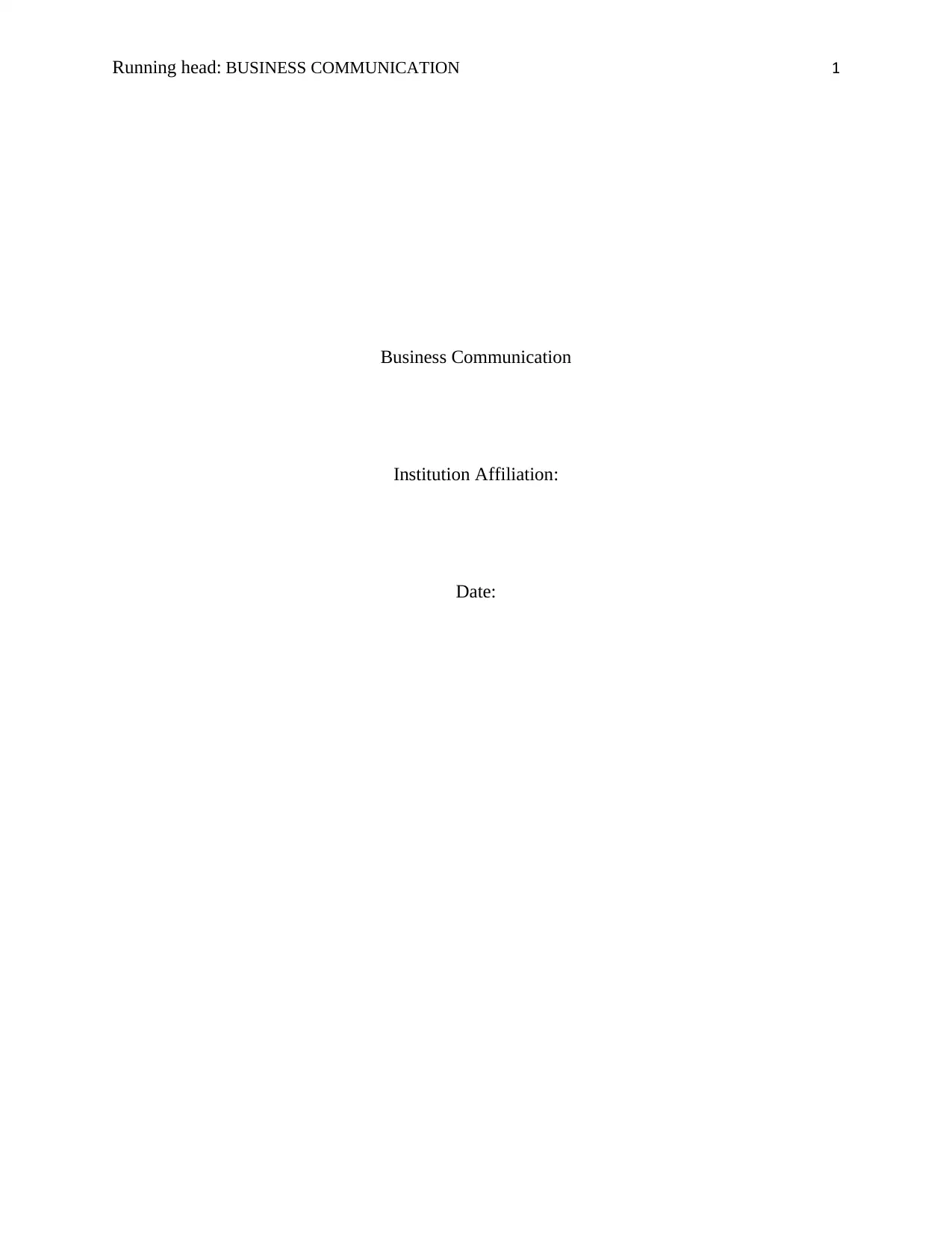
Running head: BUSINESS COMMUNICATION 1
Business Communication
Institution Affiliation:
Date:
Business Communication
Institution Affiliation:
Date:
Paraphrase This Document
Need a fresh take? Get an instant paraphrase of this document with our AI Paraphraser

BUSINESS COMMUNICATION 2
1. Identify some five communication channels that can be used for business
communication.
The communication channel is a kind of media by which a message could possibly be delivered
and acquired (Darics, 2015). The following are some of the communication channels which are
used in the business communication.
Face to face
This is among the richest channels of communication that can be employed within a business.
Physical visibility, tone of speakers’ voice as well as the facial expressions assists the recipients
of the message to be able to interpret that message as the speaker intended (Berger, 2015).
Broadcast media
TV, radio stations and loud speakers all falls under the group of the transmit media
communication channel (Berger, 2015). These types of media ought to be employed whenever
addressing the mass audience.
Mobile communications
The mobile channel of communication needs to be employed when a private or even a complex
message has to be relayed to a person to a small group within the business (Burgoon, Guerrero &
Floyd, 2016). The usage of the mobile allows interaction exchange to occur and gives the
recipient an added advantage benefits to interpret the tone of the speakers along with the
message relayed.
Written communication
1. Identify some five communication channels that can be used for business
communication.
The communication channel is a kind of media by which a message could possibly be delivered
and acquired (Darics, 2015). The following are some of the communication channels which are
used in the business communication.
Face to face
This is among the richest channels of communication that can be employed within a business.
Physical visibility, tone of speakers’ voice as well as the facial expressions assists the recipients
of the message to be able to interpret that message as the speaker intended (Berger, 2015).
Broadcast media
TV, radio stations and loud speakers all falls under the group of the transmit media
communication channel (Berger, 2015). These types of media ought to be employed whenever
addressing the mass audience.
Mobile communications
The mobile channel of communication needs to be employed when a private or even a complex
message has to be relayed to a person to a small group within the business (Burgoon, Guerrero &
Floyd, 2016). The usage of the mobile allows interaction exchange to occur and gives the
recipient an added advantage benefits to interpret the tone of the speakers along with the
message relayed.
Written communication
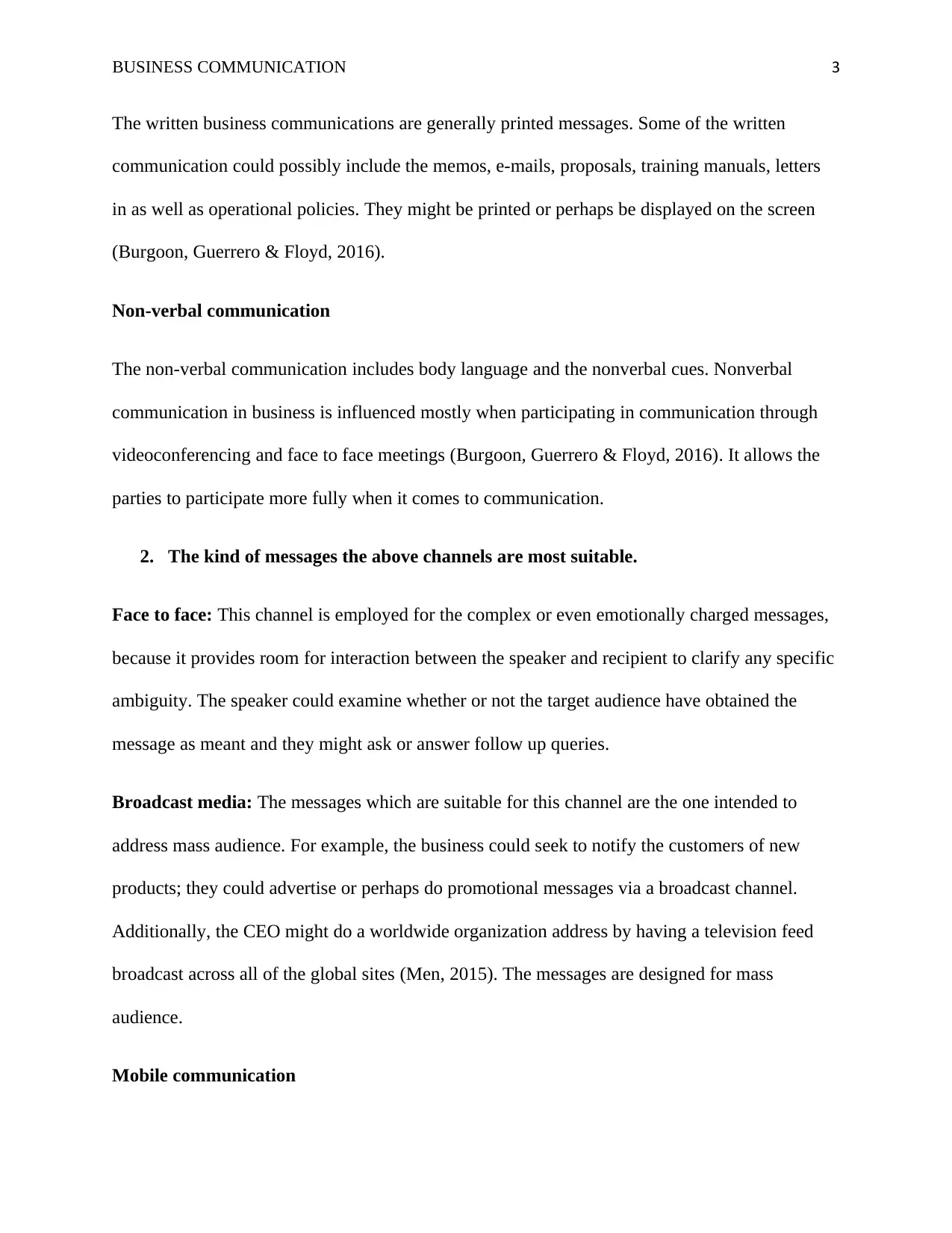
BUSINESS COMMUNICATION 3
The written business communications are generally printed messages. Some of the written
communication could possibly include the memos, e-mails, proposals, training manuals, letters
in as well as operational policies. They might be printed or perhaps be displayed on the screen
(Burgoon, Guerrero & Floyd, 2016).
Non-verbal communication
The non-verbal communication includes body language and the nonverbal cues. Nonverbal
communication in business is influenced mostly when participating in communication through
videoconferencing and face to face meetings (Burgoon, Guerrero & Floyd, 2016). It allows the
parties to participate more fully when it comes to communication.
2. The kind of messages the above channels are most suitable.
Face to face: This channel is employed for the complex or even emotionally charged messages,
because it provides room for interaction between the speaker and recipient to clarify any specific
ambiguity. The speaker could examine whether or not the target audience have obtained the
message as meant and they might ask or answer follow up queries.
Broadcast media: The messages which are suitable for this channel are the one intended to
address mass audience. For example, the business could seek to notify the customers of new
products; they could advertise or perhaps do promotional messages via a broadcast channel.
Additionally, the CEO might do a worldwide organization address by having a television feed
broadcast across all of the global sites (Men, 2015). The messages are designed for mass
audience.
Mobile communication
The written business communications are generally printed messages. Some of the written
communication could possibly include the memos, e-mails, proposals, training manuals, letters
in as well as operational policies. They might be printed or perhaps be displayed on the screen
(Burgoon, Guerrero & Floyd, 2016).
Non-verbal communication
The non-verbal communication includes body language and the nonverbal cues. Nonverbal
communication in business is influenced mostly when participating in communication through
videoconferencing and face to face meetings (Burgoon, Guerrero & Floyd, 2016). It allows the
parties to participate more fully when it comes to communication.
2. The kind of messages the above channels are most suitable.
Face to face: This channel is employed for the complex or even emotionally charged messages,
because it provides room for interaction between the speaker and recipient to clarify any specific
ambiguity. The speaker could examine whether or not the target audience have obtained the
message as meant and they might ask or answer follow up queries.
Broadcast media: The messages which are suitable for this channel are the one intended to
address mass audience. For example, the business could seek to notify the customers of new
products; they could advertise or perhaps do promotional messages via a broadcast channel.
Additionally, the CEO might do a worldwide organization address by having a television feed
broadcast across all of the global sites (Men, 2015). The messages are designed for mass
audience.
Mobile communication
⊘ This is a preview!⊘
Do you want full access?
Subscribe today to unlock all pages.

Trusted by 1+ million students worldwide
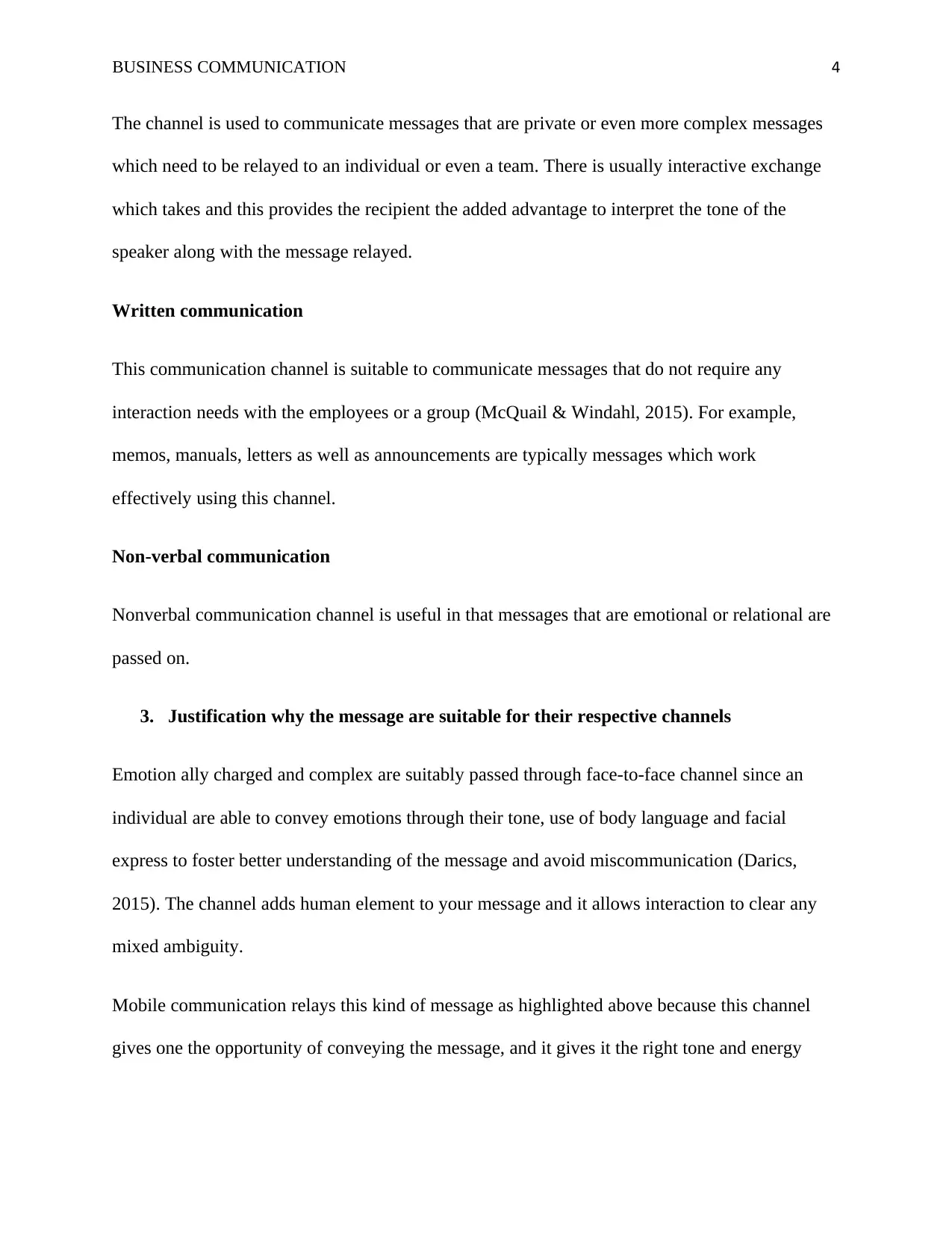
BUSINESS COMMUNICATION 4
The channel is used to communicate messages that are private or even more complex messages
which need to be relayed to an individual or even a team. There is usually interactive exchange
which takes and this provides the recipient the added advantage to interpret the tone of the
speaker along with the message relayed.
Written communication
This communication channel is suitable to communicate messages that do not require any
interaction needs with the employees or a group (McQuail & Windahl, 2015). For example,
memos, manuals, letters as well as announcements are typically messages which work
effectively using this channel.
Non-verbal communication
Nonverbal communication channel is useful in that messages that are emotional or relational are
passed on.
3. Justification why the message are suitable for their respective channels
Emotion ally charged and complex are suitably passed through face-to-face channel since an
individual are able to convey emotions through their tone, use of body language and facial
express to foster better understanding of the message and avoid miscommunication (Darics,
2015). The channel adds human element to your message and it allows interaction to clear any
mixed ambiguity.
Mobile communication relays this kind of message as highlighted above because this channel
gives one the opportunity of conveying the message, and it gives it the right tone and energy
The channel is used to communicate messages that are private or even more complex messages
which need to be relayed to an individual or even a team. There is usually interactive exchange
which takes and this provides the recipient the added advantage to interpret the tone of the
speaker along with the message relayed.
Written communication
This communication channel is suitable to communicate messages that do not require any
interaction needs with the employees or a group (McQuail & Windahl, 2015). For example,
memos, manuals, letters as well as announcements are typically messages which work
effectively using this channel.
Non-verbal communication
Nonverbal communication channel is useful in that messages that are emotional or relational are
passed on.
3. Justification why the message are suitable for their respective channels
Emotion ally charged and complex are suitably passed through face-to-face channel since an
individual are able to convey emotions through their tone, use of body language and facial
express to foster better understanding of the message and avoid miscommunication (Darics,
2015). The channel adds human element to your message and it allows interaction to clear any
mixed ambiguity.
Mobile communication relays this kind of message as highlighted above because this channel
gives one the opportunity of conveying the message, and it gives it the right tone and energy
Paraphrase This Document
Need a fresh take? Get an instant paraphrase of this document with our AI Paraphraser
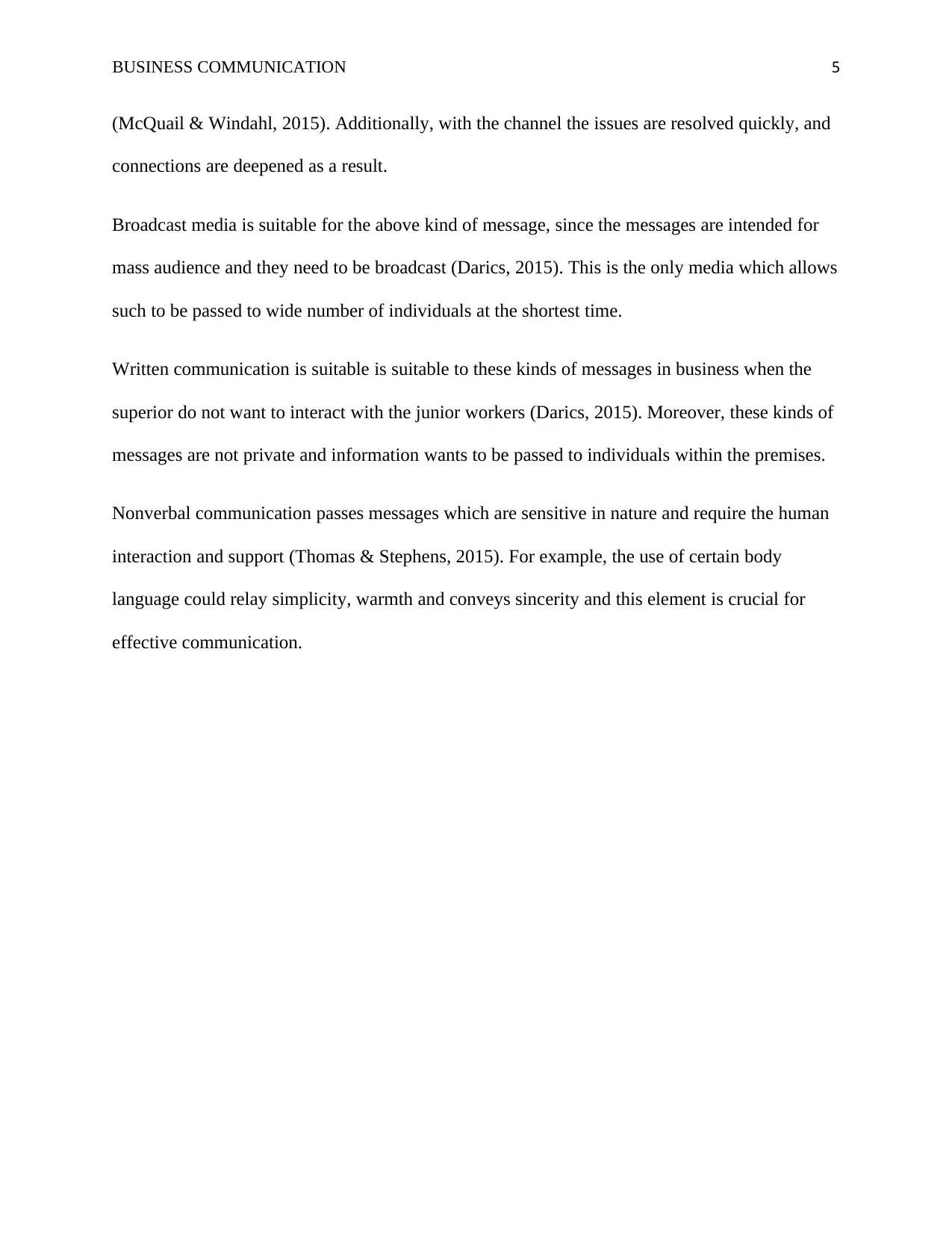
BUSINESS COMMUNICATION 5
(McQuail & Windahl, 2015). Additionally, with the channel the issues are resolved quickly, and
connections are deepened as a result.
Broadcast media is suitable for the above kind of message, since the messages are intended for
mass audience and they need to be broadcast (Darics, 2015). This is the only media which allows
such to be passed to wide number of individuals at the shortest time.
Written communication is suitable is suitable to these kinds of messages in business when the
superior do not want to interact with the junior workers (Darics, 2015). Moreover, these kinds of
messages are not private and information wants to be passed to individuals within the premises.
Nonverbal communication passes messages which are sensitive in nature and require the human
interaction and support (Thomas & Stephens, 2015). For example, the use of certain body
language could relay simplicity, warmth and conveys sincerity and this element is crucial for
effective communication.
(McQuail & Windahl, 2015). Additionally, with the channel the issues are resolved quickly, and
connections are deepened as a result.
Broadcast media is suitable for the above kind of message, since the messages are intended for
mass audience and they need to be broadcast (Darics, 2015). This is the only media which allows
such to be passed to wide number of individuals at the shortest time.
Written communication is suitable is suitable to these kinds of messages in business when the
superior do not want to interact with the junior workers (Darics, 2015). Moreover, these kinds of
messages are not private and information wants to be passed to individuals within the premises.
Nonverbal communication passes messages which are sensitive in nature and require the human
interaction and support (Thomas & Stephens, 2015). For example, the use of certain body
language could relay simplicity, warmth and conveys sincerity and this element is crucial for
effective communication.
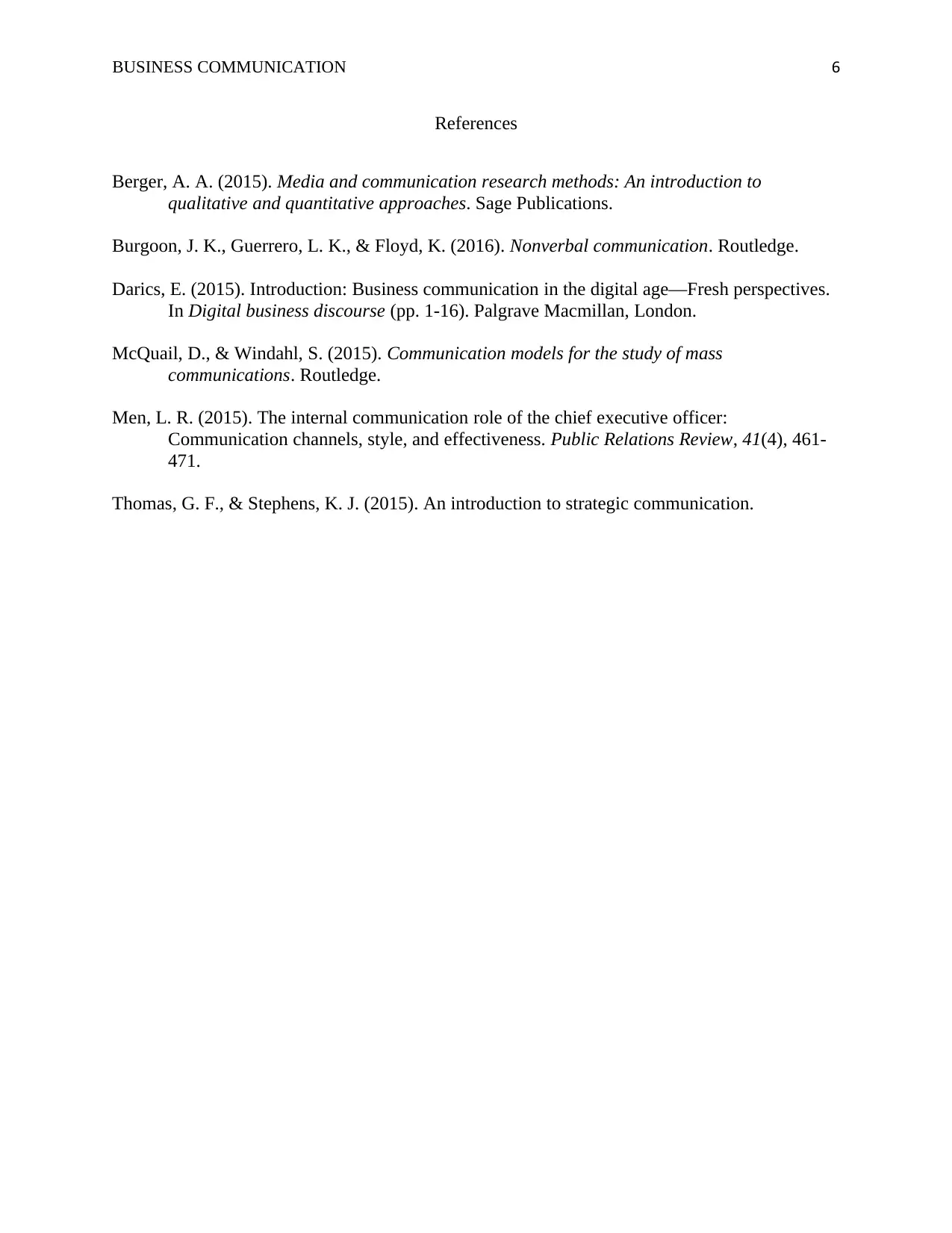
BUSINESS COMMUNICATION 6
References
Berger, A. A. (2015). Media and communication research methods: An introduction to
qualitative and quantitative approaches. Sage Publications.
Burgoon, J. K., Guerrero, L. K., & Floyd, K. (2016). Nonverbal communication. Routledge.
Darics, E. (2015). Introduction: Business communication in the digital age—Fresh perspectives.
In Digital business discourse (pp. 1-16). Palgrave Macmillan, London.
McQuail, D., & Windahl, S. (2015). Communication models for the study of mass
communications. Routledge.
Men, L. R. (2015). The internal communication role of the chief executive officer:
Communication channels, style, and effectiveness. Public Relations Review, 41(4), 461-
471.
Thomas, G. F., & Stephens, K. J. (2015). An introduction to strategic communication.
References
Berger, A. A. (2015). Media and communication research methods: An introduction to
qualitative and quantitative approaches. Sage Publications.
Burgoon, J. K., Guerrero, L. K., & Floyd, K. (2016). Nonverbal communication. Routledge.
Darics, E. (2015). Introduction: Business communication in the digital age—Fresh perspectives.
In Digital business discourse (pp. 1-16). Palgrave Macmillan, London.
McQuail, D., & Windahl, S. (2015). Communication models for the study of mass
communications. Routledge.
Men, L. R. (2015). The internal communication role of the chief executive officer:
Communication channels, style, and effectiveness. Public Relations Review, 41(4), 461-
471.
Thomas, G. F., & Stephens, K. J. (2015). An introduction to strategic communication.
⊘ This is a preview!⊘
Do you want full access?
Subscribe today to unlock all pages.

Trusted by 1+ million students worldwide
1 out of 6
Your All-in-One AI-Powered Toolkit for Academic Success.
+13062052269
info@desklib.com
Available 24*7 on WhatsApp / Email
![[object Object]](/_next/static/media/star-bottom.7253800d.svg)
Unlock your academic potential
Copyright © 2020–2025 A2Z Services. All Rights Reserved. Developed and managed by ZUCOL.


